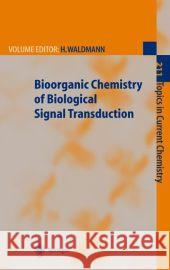Bioorganic Chemistry of Biological Signal Transduction » książka
Bioorganic Chemistry of Biological Signal Transduction
ISBN-13: 9783540677468 / Angielski / Twarda / 2000 / 230 str.
Bioorganic Chemistry of Biological Signal Transduction
ISBN-13: 9783540677468 / Angielski / Twarda / 2000 / 230 str.
(netto: 183,14 VAT: 5%)
Najniższa cena z 30 dni: 191,40 zł
ok. 20 dni roboczych.
Darmowa dostawa!
The transduction of signals from the extracellular space across the plasma membrane into the interior of cells and ultimately to the nucleus, where in - sponse to such external signals the transcription of the genetic code is inf- enced, belongs to the most fundamental and important events in the regulation of the life cycle of cells. During recent years several signal transduction cascades have been elucidated which regulate, for instance, the growth and the prolife- tion of organisms as diverse as mammals, flies, worms and yeast. The general picture which emerged from these investigations is that nature employs a c- bination of non-covalent ligand/protein and protein/protein interactions together with a set of covalent protein modifications to generate the signals and transduce them to their destinations. The ligands which are recognized may be low molecular weight compounds like lipids, inositol derivatives, steroids or microbial products like cyclosporin. They may be proteins like, for instance, growth factors or intracellular adaptor proteins which carry SH2 or SH3 domains, and they may be specific DNA stretches which are selectively rec- nized by transcription factors. These and other aspects of biological signal transduction provide an open and rewarding field for investigations by scientists from various different dis- plines of biology, medical research and chemistry working in academic research institutions or in indus











